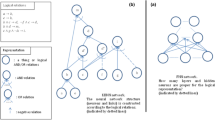Abstract
In this work an original method for coping with agents’ incomplete knowledge is introduced. This method called the algorithm for the messages generation is applied by the cognitive agents when the states of external objects can not be directly perceived. To approximate the current states of objects all agent’s experience as temporal data base is taken into account. As a result of the algorithm the logic formulas with modal operators are generated. One of the steps of proposed algorithm is the classification of the observations. It is shown how neural network approach might be used in order to determined some tendencies to occurrence specific states of objects.
Preview
Unable to display preview. Download preview PDF.
Similar content being viewed by others
References
Barreto, G.A.: Identification and Control of Dynamical Systems using the Self-Organizing Map. IEEE Trans. Neural Networks 15, 1244–1259 (2004)
Coradeschi, S., Saffiotti, A.: An Introduction to the Anchoring Problem. Robotics and Autonomous Systems 43, 85–96 (2003)
Daszykowski, M., Walczak, W., Massart, D.L.: On the Optimal Partitioning of Data with K-Means, Growing K-Means, Neural Gas, and Growing Neural Gas. J. Chem. Inf. Comput. Sci. 42, 1378–1389 (2002)
Egghe, L., Michel, C.: Construction of weak and strong similarity measures for ordered sets of documents using fuzzy set techniques. Information Processing and Management 39, 771–807 (2003)
Harnad, S.: The Symbol Grounding Problem. Physica 42, 335–236
Katarzyniak, R., Pieczynska-Kuchtiak, A.: Formal Modelling of the Semantics for Communication Languages in Systems of Believable Agents. In: Proc. of ISAT 2001, Szklarska Poreba, pp. 174–181 (2001)
Katarzyniak, R., Pieczynska-Kuchtiak, A.: Intentional Semantics for Logic Disjunctions, Alternatives and Cognitive agent’s Belief. In: Proc. of the 14th International Conference on System Science, Wroclaw, Poland, pp. 370–382 (2001)
Katarzyniak, R., Pieczynska-Kuchtiak, A.: A Consensus Based Algorithm for Grounding Belief formulas in Internally Stored Perceptions. Neural Network World 5, 671–682 (2002)
Katarzyniak, R., Pieczynska-Kuchtiak, A.: Distance Measure Between Cognitive Agent’s Stored Perceptions. In: Proc. of IASTED International Conference on Modelling, Identyfication and Control, MIC 2002, Innsbruck, Austria, pp. 517–522 (2002)
Katarzyniak, R., Pieczynska-Kuchtiak, A.: Grounding Languages in Cognitive Agents and Robots. In: Proc. of Sixteenth International Conference on System Engineering, Coventry, pp. 332–337 (2003)
Katarzyniak, R., Pieczynska-Kuchtiak, A.: Grounding and extracting modal responses in cognitive agents: AND query and states of incomplete knowledge. International Journal of Applied Mathematics and Computer Science 14(2), 249–263 (2004)
Katarzyniak, R., Pieczynska-Kuchtiak, A.: An Approach to resolving semantic inconsistency of multiple prepositional attitudes. Journal of Intelligent & Fuzzy Systems 17(3) (to appear, 2006)
Ossowski, S.: Neural Networks – algorithmic approach (in polish), WNT Warsaw (1996)
Nguyen, N.T.: Consensus System for Solving Conflicts in Distributed Systems. Information Sciences 147, 91–122 (2002)
Pieczyńska-Kuchtiak, A.: A Decision Function in the Algorithm for the Choice of Semantic Messages. In: Proc. of Information Systems Architecture and Technology, Poland (2002)
Pieczynska-Kuchtiak, A.: Towards measure of semantic correlation between messages in multiagent system. In: ICCS 2005, LNCS, Kraków, pp. 567–574 (2004)
Vogt, P.: Anchoring of semiotics symbols. Robotics and Autonomous Systems 43, 109–120 (2003)
Author information
Authors and Affiliations
Editor information
Editors and Affiliations
Rights and permissions
Copyright information
© 2006 Springer-Verlag Berlin Heidelberg
About this paper
Cite this paper
Pieczyńska, A., Drapała, J. (2006). Neural Network Approach for Learning of the World Structure by Cognitive Agents. In: Gabrys, B., Howlett, R.J., Jain, L.C. (eds) Knowledge-Based Intelligent Information and Engineering Systems. KES 2006. Lecture Notes in Computer Science(), vol 4253. Springer, Berlin, Heidelberg. https://doi.org/10.1007/11893011_128
Download citation
DOI: https://doi.org/10.1007/11893011_128
Publisher Name: Springer, Berlin, Heidelberg
Print ISBN: 978-3-540-46542-3
Online ISBN: 978-3-540-46544-7
eBook Packages: Computer ScienceComputer Science (R0)




